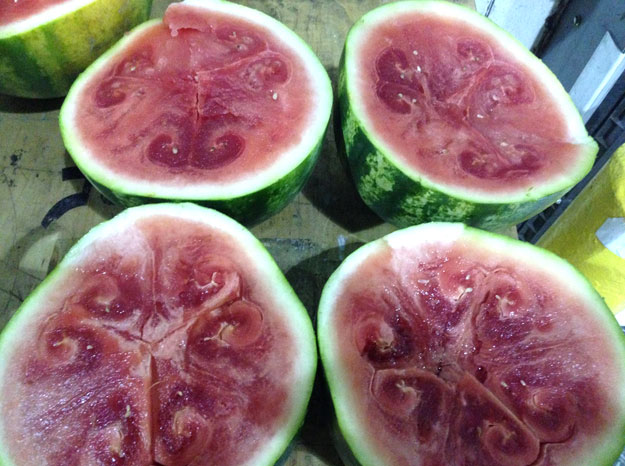Occasionally you will come across a defect that you are just not sure what it is, or how the defect is caused. You may find the unusual defect in any commodity, and here is one someone found recently.

You can plainly see the distinct watersoaking of the flesh of the watermelon. Is it second growth? I can’t say for certain, but when you are not able to identify the defect with certainty you are allowed to describe the defect, and score the watermelon or specimen as damage or as serious damage, depending on the severity. Looking at the severity of this defect, I would say these two watermelons are seriously damaged by translucent and watersoaked flesh.
But, there is one drawback….the USDA’s Inspection Instruction Guidelines. The USDA states the following:
Watersoaked Flesh (Condition Defect)
“Watermelons will absorb large amounts of water if the growing season is particularly wet or if heavy rain occurs prior to harvesting. This can result in the melons absorbing a great deal of water and the flesh having an excessively watersoaked appearance. Generally, the flesh will still be firm, at least fairly sweet and not breaking down. Melons affected with these symptoms are not scorable and should be described in general terms in the “OTHER” section on the FV-300 or under “REMARKS” on the FV-184 as not affecting grade.
Melons with watersoaked flesh that are not firm, not at least fairly sweet, have a sour odor, or are breaking down shall be scored as damage if materially affecting the appearance, or edible or shipping quality of the melon. Score as serious damage if seriously affecting the appearance, or edible or shipping quality of the melon.”
Because the USDA has no visual aids depicting what they are calling “Watersoaked Flesh” the confusion ensues. Even if the watersoaked flesh in the melons shown above is firm, are at least fairly sweet, do not have a sour odor or are not breaking down, the appearance is surely seriously affected, meeting the scoring guideline for serious damage.
Always take a picture of “odd” defects and supply the vendor, so he/she will be able to see exactly what you are describing. Case in point, if you simply rejected the watermelons as having watersoaked flesh, the USDA’s own Inspection Instructions state to ignore this defect. I am sure there is not a watermelon shipper anywhere that would expect their client to accept watermelons in this condition.
If anyone knows what causes this defect be sure and let me know, or if you think I am wrong and this should be ignored I would like to hear from you.

3 Comments on “Watermelons- Watersoaked Flesh”
To me this looks like early stages of phytopthora rot.please send flesh to your local land grant college and request a bio assay.usda handbooks need revision because this watersoaked flesh seriously detracts from the appearance and I would return it if I purchased it at the store.
Thanks for finally talking about Watermelons- Watersoaked Flesh | Loved it!
This appears to be damaged ovaries of the triploid watermelon do to virus pressure.